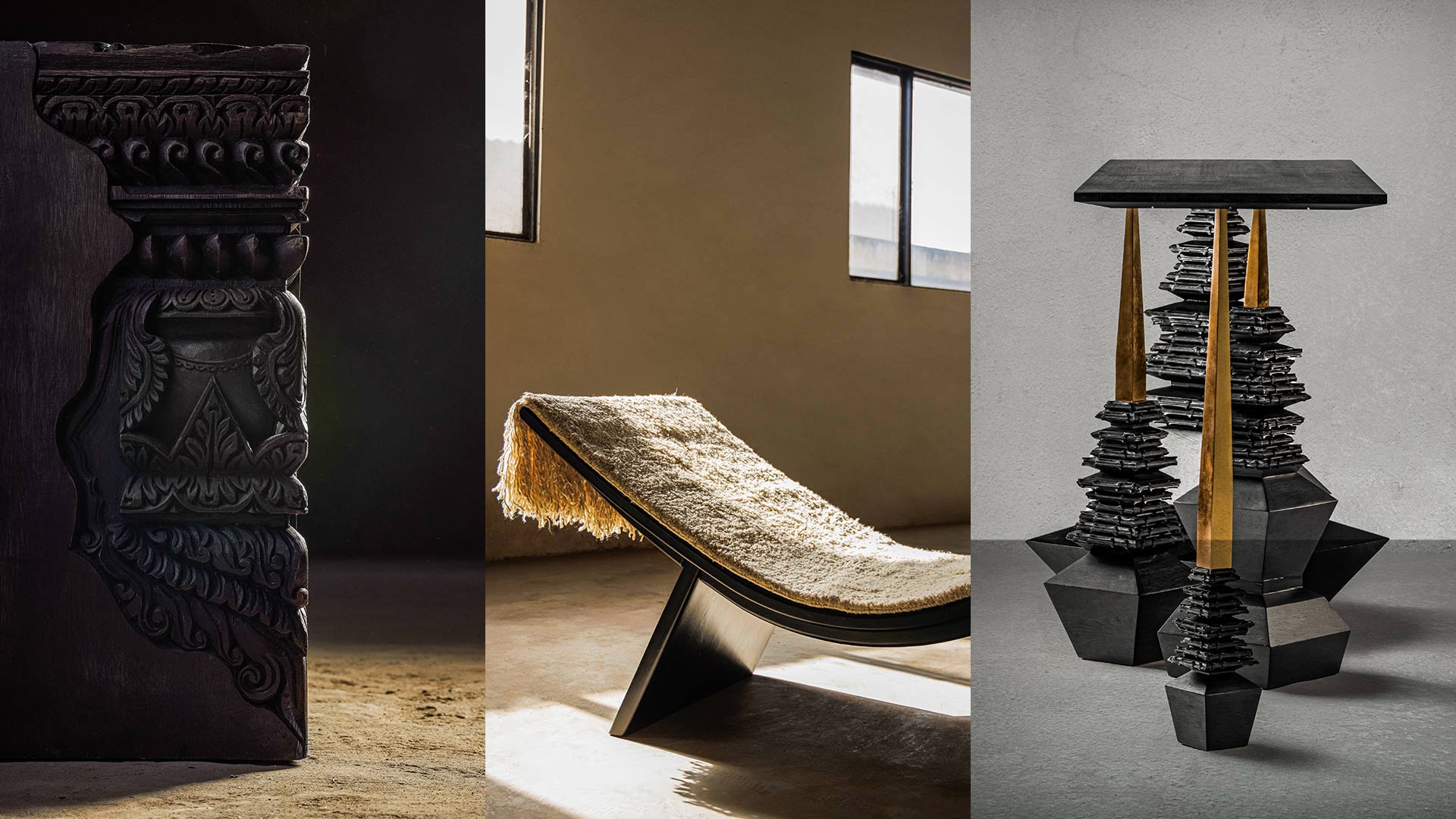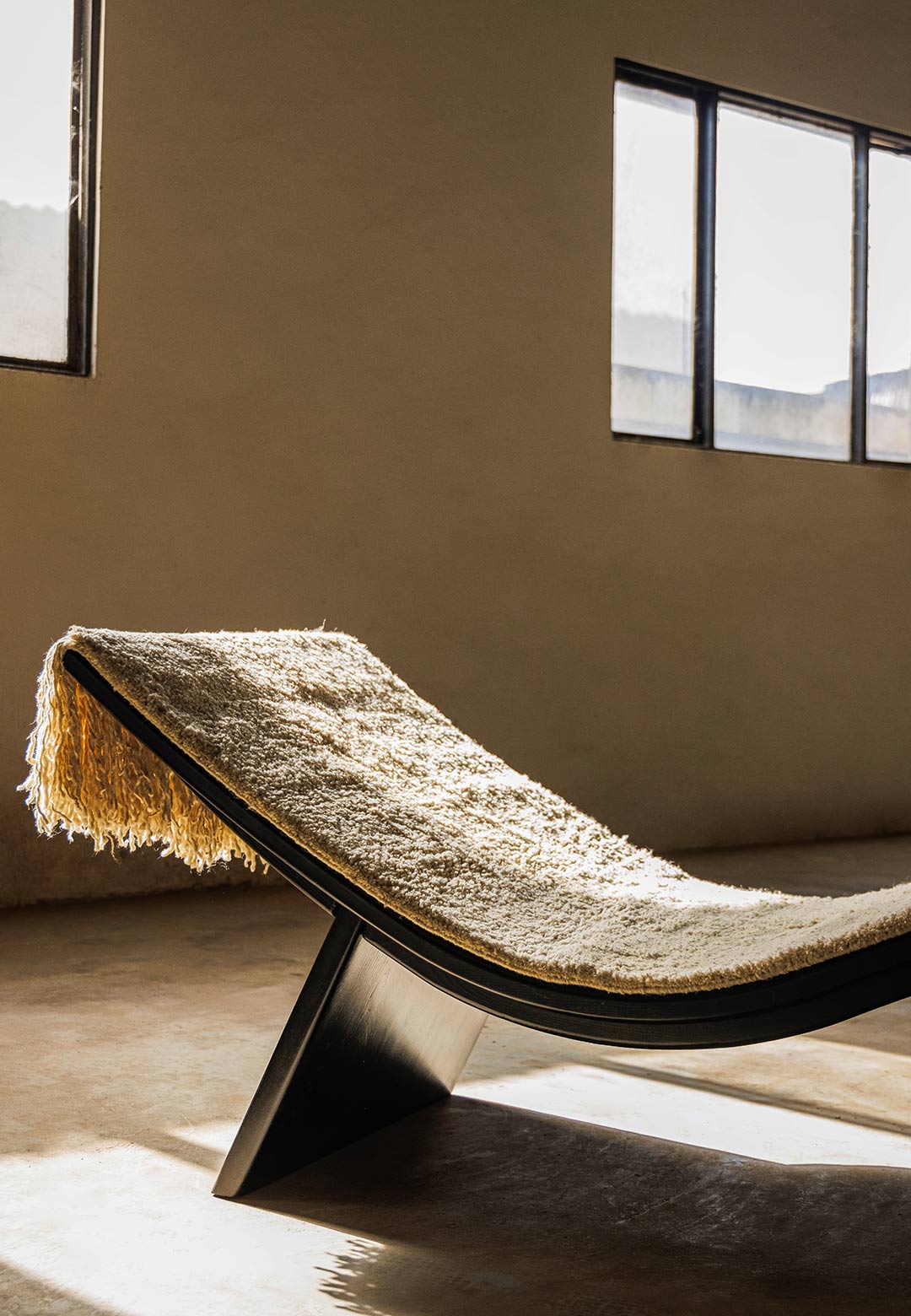Mana Collective’s Dhyan collection is a meld of archaic relics, craftsmanship techniques from the yesteryear, and a fond nostalgia—pertaining to Nepali art and architecture—carried by Aditi Kedia and Harshitaa Agrawal. The two creatives, having grown up in Kathmandu, Nepal, surrounded by architectural wonders characterised by Nepalese pagodas, wooden columns and Newar windows (now construed outdated and, hence, often discarded in favour of minimalist designs), returned to the country after completing their education, only to realise that these relics from the past continued to fascinate them. Armed with the technical expertise made requisite for designers in contemporary times, Kedia and Agrawal decided to delve into examining the essence and process that defines and shapes the intricate craft they had continued to remain in awe of. This quest led to the creation of the Dhyan collection, a series of furniture that emulates—both through its name and its design—the values of focus and dedication in shaping entities that are ravelled in clearly measured details and exquisitely construed motifs. The Dhyan collection, hence, celebrates art as a form of meditation.
Mana Collective was founded with the intention of sustaining traditional South Asian crafts by reinterpreting their features in a contemporary format. While the Nepalese studio’s latest collection, Dhyan, extols the architectural history of the Kathmandu valley, the designers intend to emulate various other artistic renditions from South Asia, in their upcoming work. The Dhyan collection is the result of thorough research, collaboration with local artisans, and a blend of traditional wood carving skills and modern crafting techniques.
It comprises five customisable objects, the ‘Abhyas’ accent table, the ‘Sadhna’ side table, the ‘Anica’ console table, the ‘Sthir’ daybed, and the ‘Manan’ jaali or screen. Each piece of furniture, named after different states of being, expresses the various aspects of meditation. ‘Abhyas,’ which translates to ‘practice’ from Hindi, reflects an artisan’s devotion to their craft through a meticulously chiselled corner emerging from underneath a plain chunk of wood. The ‘Sadhna’ side table, named after the act of meditation, or, perhaps, contemplation and introspection, is a furniture design that stands erect, much like an ascetic would, when in a state of reflection. “The strength of the table lies on the smallest part of the design, the centre. Much like how we put all our focus onto one pint while meditating, the centre is the point of concentration where balance is achieved and the table stands tall,” the studio shares.
‘Anika,’ which translates to gracefulness from Sanskrit, clearly emulates the tiered pagoda-style structures found in and around the Kathmandu valley. Just as the architectural structures are known to integrate sacred geometry comprising specific proportions and ratios carrying cosmic and metaphysical implications, ‘Anika,’ too, is crafted to echo precise geometric forms. The ‘Sthir’ daybed, inspired by the tradition of siesta, fulfils its denominated function of ascertaining stillness and stability; and the ‘Manan’ screen, made out of woven wood latticed in floral patterns, and inspired by the traditional Nepali ankhe jhyal lattice window, evokes visceral memories of unfamiliar pasts.
In order to understand more about the studio’s practice, processes and aspirations, we established a dialogue with Kedia and Agrawal. Edited excerpts from the conversation are below:
Almas Sadique: What led to the creation of Mana Collective? Tell us about the people that make up the studio.
Mana Collective: The studio was founded by two designers, Aditi Kedia, a product designer, and Harshitaa Agrawal, an interior architect. Growing up in Kathmandu surrounded by beautifully crafted architecture and crafts inspired us deeply, fueling our passion for design. After returning home from our design education, we continued to be fascinated by the craft but now aimed to understand and research the detailed work behind it.
While appreciating the craft, we also wanted to address the reduced demand for it. In today's world where most things are produced at an industrial scale, there is a strong preference for quick and cost-effective alternatives over labour-intensive processes. Unfortunately, these approaches often result in imitations lacking the true essence of the craft. Additionally, we observed that the traditional furniture struggled to fit into modern homes. As a product designer and an interior architect, we joined forces to create a collection that revitalises the wood carving process, blending contemporary elements with timeless traditions.
Almas: Why the name 'Mana' for the studio, and 'Dhyan' for the collection?
Mana Collective: We named the studio 'Mana' because it represents the power of nature in a person or object, reflecting our belief that objects carry the intention with which they are made. As for the collection, 'Dhyāna' was chosen because it requires immense focus, required to pursue crafts of the Himalayan Region.
Almas: What was the process of creating the pieces--from developing the concept behind the collection to finally building it? Who are the collaborators?
Mana Collective: Our journey started with a thorough exploration and research of the region's crafts, uncovering shared themes and captivating stories. From the very beginning, we were playing with the concept of Meditation of Making (the meditative nature of crafts in Kathmandu). This exploration guided us toward a specific craft we were eager to delve into. Collaborating with skilled artisans and expressing our ideas through sketches, we initiated the creative process.
The process to get to the final product was extremely experimental and iterative. With every iteration and design, we delved deeper into the nuances of joinery, tools, and their inherent constraints. Each experiment became a new puzzle to solve, propelling us to craft innovative designs. Following our quest, we found ourselves in a workshop in Bhaktapur, where a group of craftsmen welcomed our experimental approach with enthusiasm.
Almas: What are the different materials used to build the pieces and where are they (raw materials) acquired from?
Mana Collective: The choice of materials and finishes draws inspiration from the traditional techniques employed in the region. For instance, the juxtaposition of brass against the dark black open-grain wood texture pays homage to the local architecture and wood treatment practices. Our collection consists of five meticulously crafted objects, each thoughtfully using materials that enhance both its form and function. These materials include three types of wood - American White Ash, Indian Rosewood, and Teak, along with metal elements like brass.
Almas: Describe the perfect locale for placing the Dhyan furniture.
Mana Collective: The Dhyan furniture collection is crafted to make a statement. The neutral finishes and natural surfaces make it extremely versatile. Picture the ‘Anica’ console table gracing an entry foyer, making a stylish first impression. The ‘Abhyas’ and ‘Sadhana’ side tables become striking statement pieces in a living room, adding a touch of tradition and character. Finally, the ‘Sthir’ daybed creates the perfect reading and siesta nook, offering both comfort and style. Each Dhyan piece is meticulously designed to elevate its surroundings, making a lasting impact in various spaces throughout the home.
Almas: Will this collection have more pieces?
Mana Collective: Yes, We are soon to launch a collection of coffee tables.
Almas: What's NEXT for Mana Collective?
Mana Collective: As we grow, we will continue to explore different crafts of Southeast Asia and its modern interpretations.






 Sign in with email
Sign in with email










What do you think?